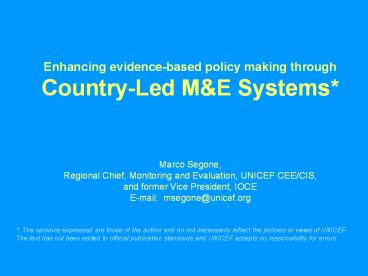Enhancing evidence-based policy making through. Country-Le - PowerPoint PPT Presentation
1 / 18
Title:
Enhancing evidence-based policy making through. Country-Le
Description:
Enhancing evidence-based policy making through. Country-Led M&E Systems* Marco Segone, ... Lobby system. Think-tank. Opinion leaders. Media. Civil Society ... – PowerPoint PPT presentation
Number of Views:66
Avg rating:3.0/5.0
Title: Enhancing evidence-based policy making through. Country-Le
1
Enhancing evidence-based policy making
throughCountry-Led ME Systems
Marco Segone, Regional Chief, Monitoring and
Evaluation, UNICEF CEE/CIS, and former Vice
President, IOCE E-mail msegone_at_unicef.org
The opinions expressed are those of the author
and do not necessarily reflect the policies or
views of UNICEF. The text has not been edited to
official publication standards and UNICEF accepts
no responsibility for errors.
2
Based on book published by UNICEF in partnership
with key international institutions
- Authors
- 21 global evaluation leaders
- Partnership
- UNICEF, WB, UNECE, IDEAS, IOCE, DevInfo and MICS
- Available for free download at
- http//www.unicef.org/ceecis/resources_10597.html
3
- 1. ME should be instrumental in ensuring
effective decision making , by providing strong
evidence. Then - Why is ME not playing its role to its full
potential? - What are the factors, in addition to the quality
and adequacy of the evidence, influencing the
decision-making process in organizations and
societies? - How can the uptake of evidence in decision-making
be increased?
4
What is Evidence-based Policy making?
An approach that helps people make well informed
decisions about policies, programmes and projects
by putting the best available evidence at the
heart of policy development and implementation.
5
Putting the best available evidence at the heart
of policy making?
Systematic review evidence
Evaluation evidence
High
Qualitative research evidence
Technical quality and trustworthiness
Experimental and quasi-experimental evidence
Low
Survey and Administrative evidence
Consultative techniques
Low
High
Enabling policy environment
6
Putting the best available evidence at the heart
of policy making?
High
Technical quality and trustworthiness
Low
Low
High
Enabling policy environment
Judgement
Experience
Resources
- Lobby system
- ?Think-tank
- ? Opinion leaders
- ? Media
- ? Civil Society
Timing of the analysis
7
Putting the best available evidence at the heart
of policy making?
Systematic review evidence
Evaluation evidence
Qualitative research evidence
Technical quality and trustworthiness
Vicious circle countries
Experimental and quasi-experimental evidence
Low
Survey and Administrative evidence
Opinion-based
Consultative techniques
Low
Enabling policy environment
- Lobby system
- ?Think-tank
- ? Opinion leaders
- ? Media
- ? Civil Society
Judgement
Experience
Resources
Timing of the analysis
8
Putting the best available evidence at the heart
of policy making?
Systematic review evidence
Evidence demand-constrained countries
Evaluation evidence
High
Evidence-influenced
Qualitative research evidence
Technical quality and trustworthiness
Experimental and quasi-experimental evidence
Survey and Administrative evidence
Consultative techniques
Low
Enabling policy environment
- Lobby system
- ?Think-tank
- ? Opinion leaders
- ? Media
- ? Civil Society
Judgement
Experience
Resources
Timing of the analysis
9
Putting the best available evidence at the heart
of policy making?
Systematic review evidence
Evaluation evidence
Qualitative research evidence
Technical quality and trustworthiness
Evidence supply-constrained countries
Experimental and quasi-experimental evidence
Low
Survey and Administrative evidence
Evidence-influenced
Consultative techniques
High
Enabling policy environment
- Lobby system
- ?Think-tank
- ? Opinion leaders
- ? Media
- ? Civil Society
Judgement
Experience
Resources
Timing of the analysis
10
Putting the best available evidence at the heart
of policy making?
Systematic review evidence
Virtuous circle countries
Evaluation evidence
High
Evidence-based
Qualitative research evidence
Technical quality and trustworthiness
Experimental and quasi-experimental evidence
Survey and Administrative evidence
Consultative techniques
High
Enabling policy environment
- Lobby system
- ?Think-tank
- ? Opinion leaders
- ? Media
- ? Civil Society
Judgement
Experience
Resources
Timing of the analysis
11
Evidence into practice Increasing the uptake of
evidence in policy making
Data Users (Policy Makers)
Data Providers (Statisticians, Evaluators,
Researchers)
Need to improve dialogue
How?
What ? Why? When?
Getting appropriate Buy-in
Incentives to use evidence
Improving usability of evidence
Reliable and trustworthy evidence
Effective dissemination
Wide Access
12
The quality challenge How to match technical
rigour and policy relevance?
Technical rigour but no policy relevance
Policy relevance but no technical rigour
Better evidence, technically rigorous and policy
relevant.
13
Country-led ME systems (CLES)a strategy to
match technical rigour with policy relevance
Technical rigour but no policy relevance
Better Policies
Better Development Results
Policy relevance but no technical rigour
Better evidence, technically rigorous and policy
relevant
14
Country-led ME systems what?
- Country (and not donors) leads and owns the
evaluation process by determining - what policy or programme will be evaluated
- (including donors coordination and alignment)
- what evaluation questions will be asked
- what methods will be used
- what analytical approach will be undertaken
- how findings will be communicated
- how findings will be used
15
Country led?
- Not exclusively the Government
- Also civil society, including Professional
evaluation organizations (from 15 to 70 in a
decade)
16
National ownership and capacity development the
key ingredients to CLES
Mutual accounta bility
Managing for results
Harmoni zation
Alignment
Ownership
17
Partner countries exercise effective leadership
over their development policies and strategies
Paris Declaration Commitment
- Partner countries exercise leadership in
developing and implementing their national
development strategies - Donors respect partner country leadership and
help strengthen their capacity to exercise it.
Implications to the ME Function
- Strengthen and use country ME systems
- ME capacity development
18
What are the challenges and way-forward?
- On you view and experience
- What are the challenges to implement country-led
ME systems? What are the perceived risks by
partner countries and by donors ? - What are the way forward? Whats the role of
national evaluation organizations and
International organizations?































